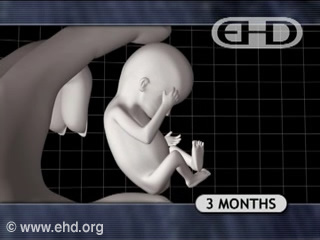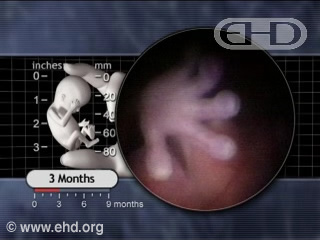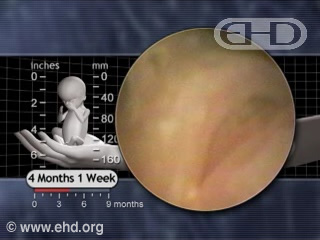Prenatal Form and Function – The Making of an Earth Suit
Unit 13: 3 to 4 Months (12 to 16 Weeks)
 Closer Look:
Closer Look:
 Applying the Science:
Applying the Science:

Copyright © 2006 EHD, Inc. All rights reserved.

A division between the oral and nasal cavities forms this week as the opening in the roof of the mouth fuses shut. 1Fetuses often touch their mouths, sometimes up to 50 times per hour.2The jaw opens reflexively in response to pressure at the base of the thumb.3
The maturing pituitary gland begins producing TSH (thyroid stimulating hormone), FSH (follicular stimulating hormone), LH (luteinizing hormone)and PL (prolactin).4 Other glands, such as the thyroid gland, also make their presence known by producing hormones.5
Up to this point in development, sodium and water transfer through the skin helped regulate the volume of amniotic fluid.6 By 12 weeks, as the skin continues to thicken, this transfer is no longer possible.

Copyright © 2006 EHD, Inc. All rights reserved.

Copyright © 2006 EHD, Inc. All rights reserved.

The second trimester of pregnancy begins at 13 weeks. Between 13 and 15 weeks, the four lobes of the cerebral cortex have developed.7 The face continues to mature: the nasal plugs disappear,8 fat deposits fill out the cheeks9 and tooth development begins.10
Growth of the lining of the large airways is well underway with cilia appearing for the first time at 13 weeks.11 Cilia are tiny hair-like projections extending from cells lining the airway. They serve to trap and move mucous and debris toward the throat. Cilia provide an important defense against foreign material and some infections. Mature cells lining the airways will have approximately 200 cilia each.12

From a teething toddler to a child losing her baby teeth, our teeth go through many stages – the first of which starts in the womb where tooth development begins by 13 weeks.



Gender dependent developmental differences appear for the first time starting at 14 weeks. For instance, female fetuses exhibit mouth movement more frequently than males and this difference increases with advancing age.13 In contrast to the withdrawal response seen earlier, stimulation near the mouth now evokes a turn toward the stimulus while the fetus opens the mouth.14 This reflex mimics the rooting reflex15 which persists after birth to help the newborn find his or her mother’s nipple during breastfeeding.16

Quickening
Quickening: originally quick meant living, as in the old phrase "the quick and the dead." In the fourteenth century, Chaucer used the word as the opposite of dead: "Nat fully quyke, ne fully dede they were." We still use the word to mean the part that is alive in expressions like "the quick of the nail" although mostly we use the word to mean rapid or swift or brief. Quick can also mean lively or alert or sharp as in "quick wit." Quickening is the first time a woman feels the fetus moving, generally between 16 and 20 weeks after fertilization for a first-time mother or between 14 and 18 weeks thereafter. After the first pregnancy, women better know what to expect. Body shape and size also influences the timing: smaller and thinner women experience quickening earlier than do their larger and less svelte counterparts. Fetal position and placenta location can also influence when a woman feels movement.
Geoffrey Chaucer, The Canterbury Tales, The Knight's Tale, Line 157.
The Concise Oxford Dictionary, Judy Pearsall, Editor, (New York: Oxford University Press, 1999), 1174.
The American Heritage Dictionary of the English Language, 3rd Edition, (Boston: Houghton Mifflin, 1992), 1484.
John Ayto, Dictionary of Word Origins (New York: Arcade, 1990), 426.
Although movement begins in the six week embryo,17 a pregnant woman first senses fetal movement between 14 and 18 weeks.18 Traditionally, this event has been called quickening.19

By 16 weeks, the fetus produces many of the same hormones found in adults. Painful procedures trigger a hormonal stress response. As in newborns and adults, pain is followed by the release of cortisol (kor’ti’sol), ß-endorphins (ba’ta en’dor-finz), and norepinephrine (nor’ep’i-nef’rin) into the blood stream.20

By 15 weeks stem cells arrive and multiply in the bone marrow.21 Most blood cell formation will eventually occur here. In the respiratory system, the bronchial tree is now nearly complete.22 All airways contain smooth muscle and nerve bundles.23
| 1 | Moore and Persaud, 2003. 230. |
| 2 | Butterworth and Hopkins, 1993. 182. |
| 3 | Valman and Pearson, 1980. 234. |
| 4 | Pilavdzic et al., 1997. 165. |
| 5 | Pringle, 1988. 178. |
| 6 | Pringle, 1988. 178-179. |
| 7 | England, 1983. 54-D. |
| 8 | Moore and Persaud, 1998. 242; Nishimura, 1993. 140, 143. |
| 9 | Poissonnet et al., 1983. 7; Poissonnet et al., 1984. 3. |
| 10 | Pringle, 1988. 178. |
| 11 | DiFiore and Wilson, 1994. 221. |
| 12 | Guyton and Hall, 2000. 441. |
| 13 | Hepper et al., 1997. 1820. |
| 14 | Mancia, 1981. 351. |
| 15 | Valman and Pearson, 1980. 234. |
| 16 | Bates, 1979. 419. |
| 17 | Visser et al., 1992. 175-176. |
| 18 | Cunningham FG et al., 2001. 23-24; Leader, 1995. 595; Sorokin and Dierker, 1982. 720. |
| 19 | Sorokin and Dierker, 1982. 720; Spraycar, 1995. 1479; Timor-Tritsch et al., 1976. 70. |
| 20 | Giannakoulopoulos et al., 1999. 494, 498-499; Giannakoulopoulos et al., 1994. 80; Glover and Fisk, 1999. 883; Smith et al., 2000. 161. |
| 21 | Pringle, 1988. 179. |
| 22 | DiFiore and Wilson, 1994. 221-222; Pringle, 1988. 178. |
| 23 | Sparrow et al., 1999. 550. |









